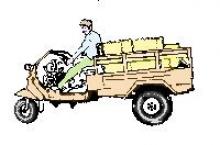Labour-saving technologies and practices: small-scale motorised transport
The following provides information on the features of single-axle tractors and small three-wheeled motorized vehicles. How they are advantageous in terms of cropping systems, specifically irrigated or wetland agriculture is also explained. The advantages and disadvantages of their use are also provided in terms of labour saving, livelihood resilience strengthening, livelihood diversification, cost, equipment and risks.
Description
1. Features of single-axle tractors
- Single-axle tractors can be used for a wide range of crop cultivation, harvesting and transport activities under limited conditions.
- They range in power from around 1.5 to 15 kW, usually around 4 kW.
- They are controlled by the operator sitting on the trailer when used for transport.
- Typical carrying capacity is 1 200 kg at up to 10 km per hour.
- The weight that they can transport is roughly the same that as that from a cart with a pair of oxen (1 500 kg) but the speed is three times as fast.
- The versatility and relatively low cost of single-axle tractors is a significant advantage in suitable cropping systems, especially irrigated or wetland agriculture.
- They can be used with a rotovator for land preparation and weeding under irrigated conditions, with a front attachment for harvesting, and with a trailer for transport.
2. Features of small three-wheeled motorized vehicles
- A range of small vehicles is available, and they operate with varying degrees of success.
- Motorized tricycles have been used as taxis for many years and are also used in rural areas for carrying light loads (around 400 kg) and travel up to 50 km per hour.
- They use the same components as small motorcycles.
3. Advantages
- Labour-saving
- This technology substantially reduces drudgery and the speed with which goods can be transported is much higher than with draught animals.
- The time and energy saved can be used for other purposes and activities.
- Livelihood resilience strengthening
- Improved transport capability improves business development potential (such as timely marketing of farm produce) and reduces transport bottlenecks and delays.
- Livelihood diversification
- The technology provides opportunities for off-farm earning potential through providing rural transport services.
- Cost
- The technology is relatively low cost compared with standard trucks. Hence it is of a lower risk than standard trucks.
4. Disadvantages
- Livelihood diversification
- There is a lack of cash from farmers to pay for hiring services.
- Equipment
- The equipment is relatively complex with engines requiring servicing and technical expertise.
- Cost and risk
- There are high ownership costs compared to draught animals and hence higher financial risks.
- There are also significant cash and foreign exchange requirements.
- Skills and knowledge
- Operator training and skilled mechanics for repair and maintenance are required.
- Infrastructure
- Considerable infrastructure support is required for their efficient operation (although less than that required for four wheeled tractors).
- This includes skilled repair and maintenance services, access to spare parts, roads in reasonable condition, and financial services to assist farmers with initial purchase.
Figure 1. Three wheeled vehicle in farm use

©FAO/TECA
5. Agro-ecological zones
- Tropics, warm.
6. Related/associated technologies
- Labour-saving technologies and practices: single axle tractors: ID 7315
- Animal traction and single-axle tractor drawn planters in conservation agriculture: ID 7416.
- Draught animal power technologies in East Africa: ID 4535.
- Development of tools for draught animals: ID 4483.
- Labour-saving technologies and practices: draught animal power and implements: ID 7306.
- Improving the productivity of draught animal power in sub-Saharan Africa: ID 4467.
- Labour-saving technologies and practices: draught animal powered and motorised crop processing: ID 7307.
7. Objectives fulfilled by the project
7.1 Labour saving technology (LST)
The practice reduces manpower through using motorized vehicles.
7.2 Pro-poor technology
The practice improves productivity, allows for the expansion of cultivated areas, improves quality of operations, and improves timeliness.
Auteur: Rural Infrastructure and Agro-industries Division (Agricultural Machinery and Infrastructure) AGS in FAO
Organisation: The Food and Agriculture Organization of the United Nations FAO TECA
Année: 2020
Type: Pratiques
Texte intégral disponible à l'adresse: https://www.fao.org/teca/en/technologies/7316
Langue: English
